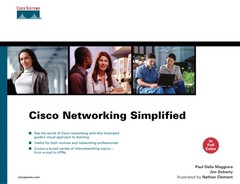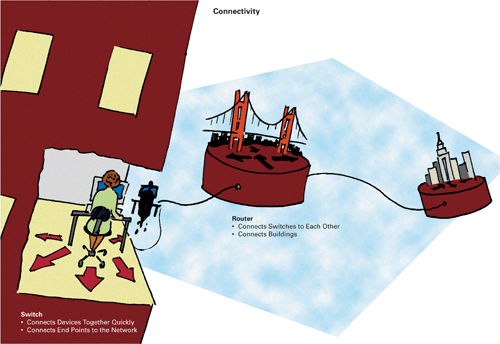Network devices have one primary purpose: to pass network traffic from one segment to another. (There are exceptions, of course, such as network analyzers, which inspect traffic as it goes by.) With devices that independently make forwarding decisions, traffic can travel from its source to the destination. The higher up the Open System Interconnection (OSI) model a device operates, the deeper it looks into a packet to make a forwarding decision.
Railroad-switching stations provide a similar example. The switches enable a train to enter the appropriate tracks (path) that take it to its final destination. If the switches are set wrong, a train can end up traveling to the wrong destination or traveling in a circle.
Bridges and switches are networking devices that operate at OSI Layer 2. Bridges became popular in the 1980s and enabled packet forwarding between homogenous networks. More recently, bridges and switches forward frames among different types of networks.
Switching technology has emerged as the evolutionary replacement for bridging. Switches provide all the features of traditional bridging and more. Compared to bridges, switches provide superior throughput performance, higher port density, and lower per-port cost.
The different types of bridging include the following:
Transparent bridging primarily occurs in Ethernet networks.
Source-route bridging occurs in Token Ring networks.
Translational bridging occurs between different media. For example, a translational bridge might connect a Token Ring network to an Ethernet network.
Bridging and switching occur at the data link layer, which means bridges control data flow, provide transmission error handling, and enable access to physical media. Basic bridging is not complicated: A bridge or switch analyzes an incoming frame, determines where to forward the frame based on the packet’s content, and forwards the frame toward its destination. With transparent bridging, forwarding decisions happen one hop at a time. With source-route bridging, the frame contains a predetermined path to the destination.
Bridges and switches divide networks into smaller, self-contained units. Because only a portion of traffic is forwarded, bridging reduces the overall traffic devices see on each connected network. The bridge acts as a kind of firewall in that it prevents frame-level errors from propagating from one segment to another. Bridges also accommodate communication among more devices than are supported on a single segment or ring. Bridges and switches essentially extend the effective length of a LAN, permitting more workstations to communicate with each other within a single broadcast domain.
The primary difference between switches and bridges is that bridges segment a LAN into a few smaller segments. Switches, through their increased port density and speed, permit segmentation on a much larger scale. Modern-day switches have hundreds of ports per chassis. Additionally, modern-day switches interconnect LAN segments operating at different speeds.
Whereas switches and bridges operate at OSI Layer 2 (data link layer), routers primarily operate at OSI Layer 3 (network layer). Like bridging, the primary act of routing involves moving packets across a network from a source to a destination. The difference involves the information that is used to make the forwarding decisions. Routers make decisions based on network layer protocols such as Internet Protocol (IP) and Novell NetWare Internetwork Packet Exchange (IPX).
Routing gained popularity in the mid to late 1980s as a result of internetworks growing beyond the capability of bridges. Before this popularity, networks were relatively small and isolated, and bridges were able to handle the jobs of forwarding and segmentation. However, as networks grew, routers facilitated larger scaling and more intelligent growth across wider physical distances. Although routers are more expensive and complex than bridges, routing is the core of the Internet today. (As a side note, Cisco as a company made its name through routing.)
Routing involves two processes: determining optimal routing paths through a network and forwarding packets along those paths. Routing algorithms make the optimal path determination. As they determine routes, tables on the router store the information.
Routing algorithms fill routing tables with various types of information. The primary piece of information relevant to routing is the next hop. Next-hop associations tell a router that it can reach a particular destination by sending a packet to a particular router representing the next hop on the way to its final destination. When a router receives a packet, it attempts to associate the destination network address in the packet to an appropriate next hop in its routing table. In addition to next-hop associations, routers store other pertinent information in routing tables. For multiple paths to a destination, a routing table might contain information that allows the router to determine the desirability of one path over another.
Routers communicate with each other and maintain their routing tables through the exchange of messages over the network. Routing updates are one particular type of message. A routing update contains all or part of another router’s routing table and allows each router to build a detailed picture of the overall network topology.
Once a router determines an optimal path for a packet, it must forward the packet toward the destination. The process of a router moving a packet from its received port to the outgoing destination port is called switching. Although the process of switching a packet on a router is similar to that of a Layer 2 switch, the decision criteria and the actual handling of the packet are different.
When a computer determines that it must send a packet to another host, it places the network address of the final destination host in the packet. However, it places the Layer 2 physical (Media Access Control [MAC]) address of the nearest router in the packet. When the router receives the packet, it first determines whether it knows how to reach the packet’s stated destination network. If the destination is not known, the router typically drops the packet. If the destination is known, the router changes the destination physical address in the packet to contain that of the next hop. The router then transmits the packet out the destination interface.
The next hop can be either the final destination or another router. Each router in the process performs the same operation. As the packet moves through the network, each router modifies the physical address stored in the packet but leaves the network address untouched (because it determines the final destination).
In an ideal world, each thing does what it is defined to do. This is not the case for network devices. Routers can provide bridging functionality, and switches are quickly becoming the high-density port, high-speed router of the campus. Network devices, including switches and routers, make forwarding decisions on OSI layers higher than the network layer. For example, routers can provide firewall functionality in which the router inspects Layer 4 packet information, and switches such as content switches can perform forwarding decisions based on Layer 5–7 packet information (such as the URL in an HTTP packet).






